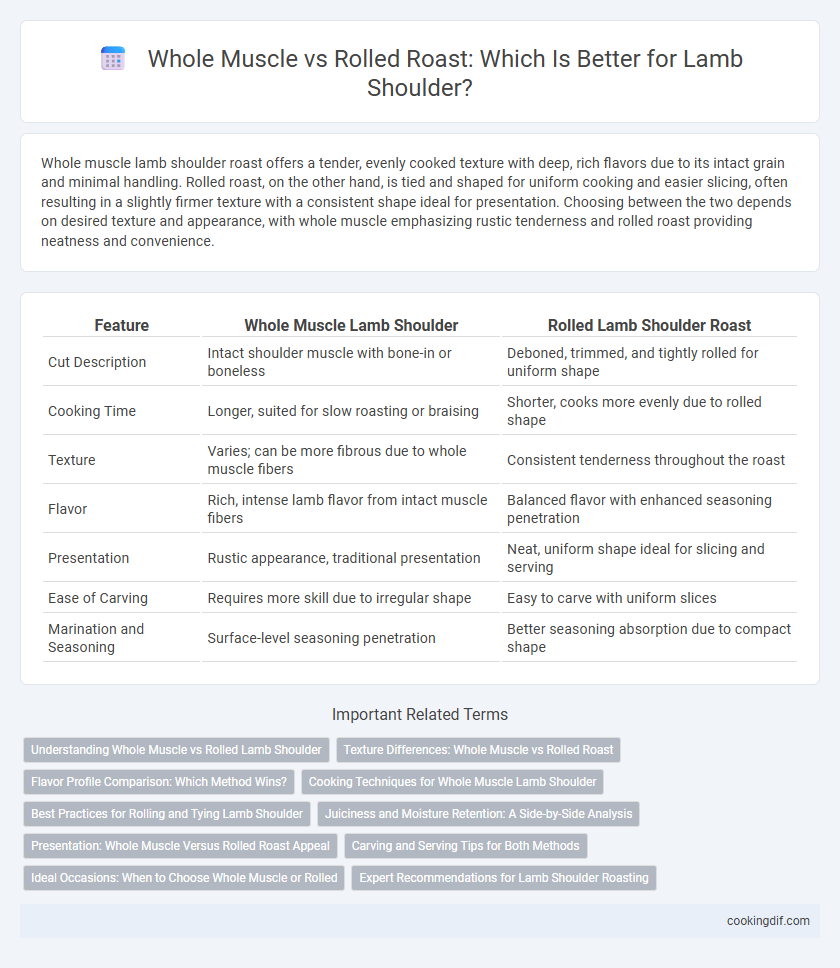Whole muscle lamb shoulder roast offers a tender, evenly cooked texture with deep, rich flavors due to its intact grain and minimal handling. Rolled roast, on the other hand, is tied and shaped for uniform cooking and easier slicing, often resulting in a slightly firmer texture with a consistent shape ideal for presentation. Choosing between the two depends on desired texture and appearance, with whole muscle emphasizing rustic tenderness and rolled roast providing neatness and convenience.
Table of Comparison
| Feature | Whole Muscle Lamb Shoulder | Rolled Lamb Shoulder Roast |
|---|---|---|
| Cut Description | Intact shoulder muscle with bone-in or boneless | Deboned, trimmed, and tightly rolled for uniform shape |
| Cooking Time | Longer, suited for slow roasting or braising | Shorter, cooks more evenly due to rolled shape |
| Texture | Varies; can be more fibrous due to whole muscle fibers | Consistent tenderness throughout the roast |
| Flavor | Rich, intense lamb flavor from intact muscle fibers | Balanced flavor with enhanced seasoning penetration |
| Presentation | Rustic appearance, traditional presentation | Neat, uniform shape ideal for slicing and serving |
| Ease of Carving | Requires more skill due to irregular shape | Easy to carve with uniform slices |
| Marination and Seasoning | Surface-level seasoning penetration | Better seasoning absorption due to compact shape |
Understanding Whole Muscle vs Rolled Lamb Shoulder
Whole muscle lamb shoulder roasts maintain the natural grain and structure of the meat, resulting in a juicier and more tender final product when slow-cooked. Rolled lamb shoulder, boned and tightly tied, offers even thickness for uniform cooking and easier carving, ideal for roasting at higher temperatures. Choosing between the two depends on desired texture and cooking method, with whole muscle preferred for slow, low heat, and rolled roast suited for quicker, more consistent roasting.
Texture Differences: Whole Muscle vs Rolled Roast
Whole muscle lamb shoulder roasts retain a coarse, fibrous texture that breaks down slowly during cooking, offering a more rustic and tender bite. Rolled roasts, tightly bound and evenly shaped, promote uniform cooking and produce a finer, more consistent texture with enhanced juiciness. The choice affects mouthfeel significantly, with whole muscle showcasing muscle grain and rolled roasts delivering a compact, sliceable result.
Flavor Profile Comparison: Which Method Wins?
Whole muscle lamb shoulder roasts retain natural juices and offer a deep, rich flavor with a tender texture that highlights the meat's inherent qualities. Rolled roasts, by contrast, create a more uniform shape for even cooking and infuse enhanced seasoning penetration, resulting in a balanced, savory taste. Flavor purists often prefer whole muscle for its robust, unadulterated lamb essence, while rolled roasts excel in consistent seasoning and texture.
Cooking Techniques for Whole Muscle Lamb Shoulder
Whole muscle lamb shoulder benefits from slow roasting or braising, preserving its tenderness and enhancing its natural juices. Maintaining the integrity of the muscle fibers allows for even cooking, resulting in a moist, flavorful roast. Using low temperatures and longer cooking times prevents drying and maximizes the development of rich, savory flavors in the lamb shoulder.
Best Practices for Rolling and Tying Lamb Shoulder
Rolled lamb shoulder roasts enable even cooking and better seasoning penetration compared to whole muscle cuts, enhancing tenderness and flavor. Best practices for rolling include trimming excess fat, evenly layering herbs and spices, and rolling tightly to maintain shape during cooking. Secure the roast with kitchen twine at 1- to 1.5-inch intervals to ensure consistent heat distribution and prevent loosening in the oven.
Juiciness and Moisture Retention: A Side-by-Side Analysis
Whole muscle lamb shoulder roasts retain more moisture and juiciness due to their intact muscle fibers and natural fat distribution, which slow down moisture loss during cooking. Rolled roasts, while convenient and uniform in shape, often experience slightly higher moisture evaporation because the cutting and rolling process exposes more surface area to heat. Cooking methods that emphasize slow, low-temperature roasting enhance the juiciness of whole muscle roasts by preserving collagen and intramuscular fats.
Presentation: Whole Muscle Versus Rolled Roast Appeal
A whole muscle lamb shoulder roast offers a rustic, visually striking presentation with a natural shape that highlights the quality of the meat, appealing to traditional and artisanal preferences. In contrast, a rolled roast provides a uniform, compact appearance ideal for even cooking and elegant slicing, enhancing plated presentation in fine dining settings. The choice between whole muscle and rolled roast influences not only cooking technique but also the visual impact, shaping the dining experience.
Carving and Serving Tips for Both Methods
Whole muscle lamb shoulder retains juiciness and texture, making carving easier with clean, uniform slices that highlight the meat's natural grain. Rolled roast offers compact shape, allowing for even cooking and convenient portioning when carved into rounds, perfect for controlled serving sizes. For serving, rest whole muscle roasts for at least 15 minutes to retain juices, while rolled roasts benefit from tight slicing to showcase the layered flavors and tender interior.
Ideal Occasions: When to Choose Whole Muscle or Rolled
Whole muscle lamb shoulder roasts are ideal for slow-cooked dishes and special family gatherings where tender, succulent meat is desired with a rustic presentation. Rolled roasts offer a more uniform shape, perfect for even cooking and elegant dinner parties or holiday meals requiring consistent slices. Choosing between whole muscle or rolled depends on whether the occasion calls for traditional rustic appeal or refined plating and controlled cooking times.
Expert Recommendations for Lamb Shoulder Roasting
Expert recommendations for lamb shoulder roasting emphasize whole muscle cuts due to their superior moisture retention and even cooking, resulting in tender, flavorful meat. Rolled roasts are favored for uniform thickness, faster cooking times, and ease of carving, making them ideal for consistent servings. Chefs suggest selecting whole muscle for traditional slow roasting and rolled roast for high-heat, quick methods to optimize texture and taste.
Whole muscle vs rolled roast for lamb shoulder Infographic

 cookingdif.com
cookingdif.com